Cantillon Don Quijote: Difference between revisions
| (53 intermediate revisions by 4 users not shown) | |||
| Line 1: | Line 1: | ||
[[File: | [[File:Bottle-CantillonDonQuijote-1.jpg |right|300px|Cantillon Don Quijote]] | ||
[[Brasserie_Cantillon#Beers|← Cantillon]] | [[Brasserie_Cantillon#Beers|← Cantillon]] | ||
__NOTOC__ | __NOTOC__ | ||
== Description == | == Description == | ||
Cantillon Don Quijote is a grape lambic from 2008 made with Italian table grapes. This beer was produced for Franco Fratoni (Livingstone Club, Florence, Italy) and Umberto Santi (Goblin Pub, Pavullo Nel Frignano, Italy). It is listed as 5% ABV. | |||
== | ==The Story of Don Quijote== | ||
[[File:Sancho and Dapple - Sketch.png|thumb|left|250px|Early sketch of Sancho and Dapple]] | |||
For Umberto Santi of Goblin Pub in Pavullo Nel Frignano, Italy and Franco Fratoni of the Livingstone Club in Florence, Italy, Don Quijote was not a simple beer or project they set out to create. It happened in a period when two paths intersected and histories briefly overlapped creating some magic of which only memories and Cantillon Don Quijote remain. Much like its namesake, the story of how this bottling came to be is a quixotic, rambling adventure involving one lambic brewer, two pub owners, and one artist whose friendship created one of the most renowned beers in lambic history. [[File:Don Quijote - Early Sketch 1.png|thumb|250px|left|Don Quijote - Early Sketch #1]]<br> <br> | |||
== | One night in 2008, after departing from Goblin Pub and stopping along the way for naps and breakfast around the abbey at Orval, Umberto and Franco arrived at Cantillon for the second time that year. Umberto was already a familiar face around Cantillon after receiving and serving their beers for years at Goblin. According to Fratoni, “the time that the magic happened we were at the [[File:Don Quijote - Early Sketch 2.png|thumb|right|250px|Don Quijote - Early Sketch #2]]tables inside the brewery and we were very much ourselves, as usual, mixing with the locals and chatting with Jean Van Roy. At that time I was more or less a homebrewer with a 150 L plant that I had bought from a closing brew pub. One of the recipes I had developed included bits of my personal history and philosophy. The characterizing ingredient was a kind of grapes that are (illegally) used to make a delicious sweet wine in Friuli, the Italian region where I was based for my military service.” A conversation began. <br> <br> | ||
The grapes used in Don Quijote are called ''Uva Fragola'' – literally “strawberry-grape” – and were given the name due to their strong strawberry-like aromatic characteristics. A North American import to Europe and known in English as Isabelle grapes, ''Uva Fragola'' falls under the ''Vitis labrusca'' species of grape rather than the traditional wine grape family of ''Vitis vinifera'', and Italian and European law forbids the official marketing or sale of wine using it. Some countries, including France, had banned its cultivation outright in the early 20th century. According to one source, “''Vitis labrusca'' is historically blamed as the American grape variety that, when brought to Europe in the 1800s, carried the phylloxera plague” <ref name = "Modern Farmer"> Modern Farmer, [https://modernfarmer.com/2013/10/best-wine-cant-buy-fragolino/ The Best Wine You Can't Buy: Fragolino] </ref> even though its importation was already underway due to its resistance to the plague, while other sources note that it was banned due to the difficulty in controlling methanol levels during the production of wines.<ref name = "Vino Proibito"> , [http://www.ragusaoggi.it/il-vino-proibito/ Il Vino Proibito]</ref> However in the Veneto region of Italy, these grapes are used in the production of Fragolino, which is a sparkling sweet red wine somewhat similar to Moscato that is becoming more and more difficult to find. [[File:Don Quijote - Early Sketch 3.png|thumb|right|250px|Don Quijote - Early Sketch #3]] | |||
As Umberto’s and Franco’s day was coming to an end at the brewery, Umberto asked Franco if it would be alright to tell Jean about the beer Franco had been producing with the Uva Fragola. Franco notes “I was quite nervous since I was well aware of the abyss between Jean and I in terms of brewing capabilities and history but I agreed… and for a magical series of circumstances we got asked if we were interested in providing those grapes for an original Cantillon.” As the two friends were exiting the brewery, they asked Jean why he would want to do this, and his reply, as seen on the label today, was “because we are crazy.” | |||
[[File:Don Quijote - Early Sketch 4.png|thumb|left|250px|Don Quijote - Early Sketch #4]] | |||
Jean recalls that the Uva Fragola were hand delivered by Franco and Umberto and likely received around the same time as his other grapes for lambics like Saint Lamvinus and Vigneronne, around mid-September. The grapes were placed into a barrel of around 350-400 L and macerated for approximately two months, which coincides with the bottling date of November 19, 2008. Given the size of the barrel, Jean believes that they must have received around 80 to 100 kilograms of grapes. This amount of grapes also means that +/- 250 liters of lambic would have been extracted, though labels on the beer indicate that 120 bottles of each size (375 mL and 750 mL) were bottled. This would mean only 135 liters worth of bottles were filled. Notably, the brewery also kegged 40 liters of the lambic, bringing the total known packaged production up to 175 liters. It may be that around 100 more bottles were packaged than indicated on the labels, but the records from the brewery are unclear. | |||
[[File:Don Quijote - Early Sketch, colored.png|thumb|right|250px|Don Quijote - Sketch #4, colored]] | |||
Perhaps one of Cantillon’s most iconic labels, the original artwork was drawn by Nicholas Butler, a childhood friend and next-door neighbor of Franco in Florence. After Umberto and Franco settled on a name for the beer to honor their quixotic nature, Nicholas was asked to come up with a concept for the label with an interpretation of the titular character. [[File:Don Quijote - Oil on Canvas.png|left|thumb|250px|Don Quijote - Oil on canvas]]Some of the initial sketches and ideas included Don Quijote attacking a windmill as he does in the story, as well as a less pensive Quijote closer to the windmill without Sancho Panza and Dapple in the background. After fleshing out the idea, the concept “matched in a perfect way to the sense of craziness, dream, melancholy, and idealistic vision of the world they had in mind”, according to Butler. Sadly, any digital renderings of the label are gone, but many of the original sketches and concepts are presented here scanned from the original papers. The fully colored version used here was commissioned by Franco and is oil on canvas. Most lambic aficionados immediately recognize the yellowed label of Don Quijote, but it is actually its second incarnation. Butler’s initial final draft of the label was a black and white label with a red sun and was initially approved by Umberto and mostly placed on the 75cl bottles. When those labels ran out, a second run was made with the colorized version that is most common today. | |||
In the end, those involved in envisioning and putting Don Qujiote into bottles view it as the outcome of many factors lining up for a brief moment in time – the history of a shunned grape, experiments in homebrewing, the nomadic experiences of two pub owners, a childhood friendship, and a chance meet up at the brewery. Nearly ten years after it was bottled, Umberto is still Metabolizing how all of these interwoven experiences set off a chain reaction that resulted in the production of one of Cantillon’s most sought after beers – an outcome he refers to as “Magic”. For him though, it has never been about the beer, but about the experiences surrounding it. And as Franco notes, “Don Quijote is a tangible outcome of a magical moment, the essence of our philosophy, not just a beer to us”. | |||
==Bottle Log== | ==Bottle Log== | ||
<center> | <center> | ||
{| class="wikitable" border="1" style="text-align: center; " | |||
{| class="mw-collapsible mw-collapsed wikitable" border="1" style="text-align: center; " | |||
|+ Bottle Log | |||
|- | |- | ||
! Bottle date | ! Bottle date | ||
(mm/dd/yyyy) | (mm/dd/yyyy) | ||
| Line 22: | Line 35: | ||
! Image Link | ! Image Link | ||
|- | |- | ||
| 11/ | | 11/20/2008 | ||
| 2008 | | 2008 | ||
| | | 375 & 750 mL | ||
| | | | ||
| N/A | | N/A | ||
| Line 38: | Line 44: | ||
|} | |} | ||
</center> | </center> | ||
== Photos == | == Photos == | ||
<gallery> | |||
File:DQ - White Label.jpg|White label, 75cl | |||
File:DQ - White Label, rear.jpg|White label, rear, 75cl | |||
File:DQ-Back Label-1.jpg|Livingstone Club Bottle | |||
File:DQ-Back Label-G-1.jpg|Goblin Pub Bottle | |||
File:CantillonDonQuijote-2.jpg | |||
File:CantillonDonQuijote-3.jpg | |||
File:CantillonDonQuijote-4.jpg | |||
</gallery> | |||
==References== | |||
<references /> | |||
[[Brasserie_Cantillon#Beers|← Cantillon]] | [[Brasserie_Cantillon#Beers|← Cantillon]] | ||
Latest revision as of 17:04, 25 June 2025

Description
Cantillon Don Quijote is a grape lambic from 2008 made with Italian table grapes. This beer was produced for Franco Fratoni (Livingstone Club, Florence, Italy) and Umberto Santi (Goblin Pub, Pavullo Nel Frignano, Italy). It is listed as 5% ABV.
The Story of Don Quijote
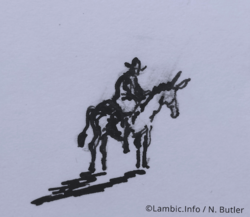
For Umberto Santi of Goblin Pub in Pavullo Nel Frignano, Italy and Franco Fratoni of the Livingstone Club in Florence, Italy, Don Quijote was not a simple beer or project they set out to create. It happened in a period when two paths intersected and histories briefly overlapped creating some magic of which only memories and Cantillon Don Quijote remain. Much like its namesake, the story of how this bottling came to be is a quixotic, rambling adventure involving one lambic brewer, two pub owners, and one artist whose friendship created one of the most renowned beers in lambic history.

One night in 2008, after departing from Goblin Pub and stopping along the way for naps and breakfast around the abbey at Orval, Umberto and Franco arrived at Cantillon for the second time that year. Umberto was already a familiar face around Cantillon after receiving and serving their beers for years at Goblin. According to Fratoni, “the time that the magic happened we were at the
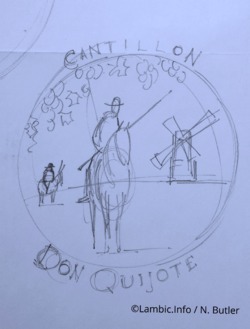
tables inside the brewery and we were very much ourselves, as usual, mixing with the locals and chatting with Jean Van Roy. At that time I was more or less a homebrewer with a 150 L plant that I had bought from a closing brew pub. One of the recipes I had developed included bits of my personal history and philosophy. The characterizing ingredient was a kind of grapes that are (illegally) used to make a delicious sweet wine in Friuli, the Italian region where I was based for my military service.” A conversation began.
The grapes used in Don Quijote are called Uva Fragola – literally “strawberry-grape” – and were given the name due to their strong strawberry-like aromatic characteristics. A North American import to Europe and known in English as Isabelle grapes, Uva Fragola falls under the Vitis labrusca species of grape rather than the traditional wine grape family of Vitis vinifera, and Italian and European law forbids the official marketing or sale of wine using it. Some countries, including France, had banned its cultivation outright in the early 20th century. According to one source, “Vitis labrusca is historically blamed as the American grape variety that, when brought to Europe in the 1800s, carried the phylloxera plague” [1] even though its importation was already underway due to its resistance to the plague, while other sources note that it was banned due to the difficulty in controlling methanol levels during the production of wines.[2] However in the Veneto region of Italy, these grapes are used in the production of Fragolino, which is a sparkling sweet red wine somewhat similar to Moscato that is becoming more and more difficult to find.
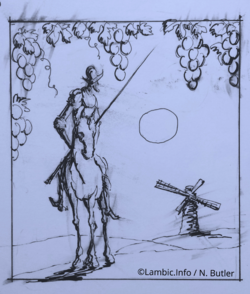
As Umberto’s and Franco’s day was coming to an end at the brewery, Umberto asked Franco if it would be alright to tell Jean about the beer Franco had been producing with the Uva Fragola. Franco notes “I was quite nervous since I was well aware of the abyss between Jean and I in terms of brewing capabilities and history but I agreed… and for a magical series of circumstances we got asked if we were interested in providing those grapes for an original Cantillon.” As the two friends were exiting the brewery, they asked Jean why he would want to do this, and his reply, as seen on the label today, was “because we are crazy.”
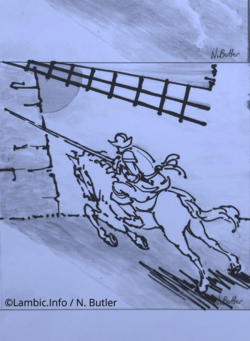
Jean recalls that the Uva Fragola were hand delivered by Franco and Umberto and likely received around the same time as his other grapes for lambics like Saint Lamvinus and Vigneronne, around mid-September. The grapes were placed into a barrel of around 350-400 L and macerated for approximately two months, which coincides with the bottling date of November 19, 2008. Given the size of the barrel, Jean believes that they must have received around 80 to 100 kilograms of grapes. This amount of grapes also means that +/- 250 liters of lambic would have been extracted, though labels on the beer indicate that 120 bottles of each size (375 mL and 750 mL) were bottled. This would mean only 135 liters worth of bottles were filled. Notably, the brewery also kegged 40 liters of the lambic, bringing the total known packaged production up to 175 liters. It may be that around 100 more bottles were packaged than indicated on the labels, but the records from the brewery are unclear.
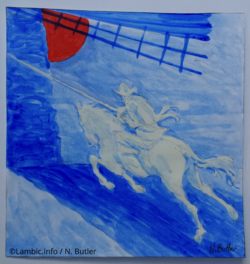
Perhaps one of Cantillon’s most iconic labels, the original artwork was drawn by Nicholas Butler, a childhood friend and next-door neighbor of Franco in Florence. After Umberto and Franco settled on a name for the beer to honor their quixotic nature, Nicholas was asked to come up with a concept for the label with an interpretation of the titular character.

Some of the initial sketches and ideas included Don Quijote attacking a windmill as he does in the story, as well as a less pensive Quijote closer to the windmill without Sancho Panza and Dapple in the background. After fleshing out the idea, the concept “matched in a perfect way to the sense of craziness, dream, melancholy, and idealistic vision of the world they had in mind”, according to Butler. Sadly, any digital renderings of the label are gone, but many of the original sketches and concepts are presented here scanned from the original papers. The fully colored version used here was commissioned by Franco and is oil on canvas. Most lambic aficionados immediately recognize the yellowed label of Don Quijote, but it is actually its second incarnation. Butler’s initial final draft of the label was a black and white label with a red sun and was initially approved by Umberto and mostly placed on the 75cl bottles. When those labels ran out, a second run was made with the colorized version that is most common today.
In the end, those involved in envisioning and putting Don Qujiote into bottles view it as the outcome of many factors lining up for a brief moment in time – the history of a shunned grape, experiments in homebrewing, the nomadic experiences of two pub owners, a childhood friendship, and a chance meet up at the brewery. Nearly ten years after it was bottled, Umberto is still Metabolizing how all of these interwoven experiences set off a chain reaction that resulted in the production of one of Cantillon’s most sought after beers – an outcome he refers to as “Magic”. For him though, it has never been about the beer, but about the experiences surrounding it. And as Franco notes, “Don Quijote is a tangible outcome of a magical moment, the essence of our philosophy, not just a beer to us”.
Bottle Log
| Bottle date
(mm/dd/yyyy) |
Cork Date | Bottle Size | Label / Notes | Image Link |
|---|---|---|---|---|
| 11/20/2008 | 2008 | 375 & 750 mL | N/A |
Photos
-
White label, 75cl
-
White label, rear, 75cl
-
Livingstone Club Bottle
-
Goblin Pub Bottle
References
- ↑ Modern Farmer, The Best Wine You Can't Buy: Fragolino
- ↑ , Il Vino Proibito






